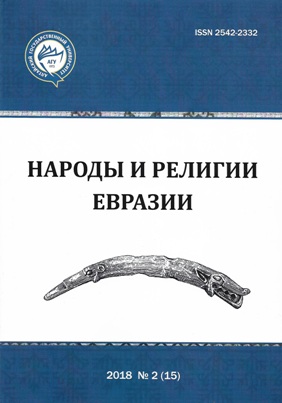The tibetan sources about Chingis-khan
Main Article Content
Abstract
The article is devoted to the problem of consideration of the Tibetan sources which authors have described Chingis-khan's childhood, youth and political activity. In the article features of the Mongolian annals of the 17th century based on Buddhism and Lamaism basis of the narration which idea consisted in the search of continuity of the Mongolian khans whose family tree started from the Indian and the Tibetan tsars are revealed; historical and political factors which have exerted impact on creation of the Mongolian chronicles of the 17th century are shown. The role of Tibetan language in formation of the Mongolian scientists and the importance of Tibetan language for the Mongolian chronicles of the 17th century is shown in the article; the attention is paid to consideration of rather long process of conquest by Mongols of Tibet and the subsequent Tibet inclusion in the structure of Mongolian Empire.
In the article views of the Tibetan chroniclers for young years of Chingis-khan are studied: factors which, according to authors, have more influenced on his formation as the great khan are revealed; activities of Chingis-khan for association of tribes and formation of Mongolian Empire are shown; and, at last, some aggressive campaigns of Chingis-khan are investigated, namely: the invasion of Mongols to Tangut State, to Jin State and partially to Turkestan.
Downloads
Metrics
Article Details
References
Бира Ш. Монгольская историография (XIII-XVII вв.). М. : Наука, 1978. 320 с.
Гомбоджаб. Ганга-йин урусхал (История золотого рода владыки Чингиса. Сочинение под названием «Течение Ганга») / изд. текста, введение и указатель Л. С. Пучков-ского. М. : Восточная литература, 1960. 66 с.
Данзан Лубсан. Алтан тобчи («Золотое сказание») / пер. с монг., введение, коммент. и прил. Н. П. Шастиной. М. : Наука, 1973. 439 с.
Жамцарано Ц. Ж. Монгольские летописи XVII века. // Труды Института Востоковедения. XVI. М. ; Л. : Изд-во Академии наук СССР, 1986. 122 с.
Кучера С. Завоевание монголами Тибета // Татаро-монголы в Азии и Европе. М. : Наука, 1977. С. 260-281.
Кычанов Е. И. Жизнь Темучжина, думавшего покорить мир. Чингис-хан. Личность и эпоха. 2-е изд., пер. и доп. М. : Восточная литература, 1995. 272 с.
Кычанов Е. И. Монголо-тангутские войны и гибель государства Си Ся // Татаро-монголы в Азии и Европе. М. : Наука, 1977. С. 46-61.
Пучковский Л. С. Монгольская феодальная историография XIII-XVII вв. // Ученые записки Института востоковедения АН СССР. Т. VI. М. ; Л., 1953. С. 130-166.
Рерих Ю. Монголо-тибетские отношения в XIII и XIV // Ю. Рерих Тибет и Центральная Азия. Статьи, лекции, переводы. Самара : Агни, 1999. С. 140-152.
Суходолов А. П., Кузьмин Ю. В., Василенко В. А. Проблемы истории, источниковедения и историографии Монголии. К 90-летию академика Шагдарын Бира // Baikal Research Journal: электронный научный журнал Байкальского государственного университета. 2017. Т. 8. № 2 [Электронный ресурс]. URL: http: // brj-bguep.ru/reader/article. aspx?d=21457/ (дата обращения: 05.01. 2018).
Цендина А. Д. Монгольские летописи XVII-XIX веков: повествовательные традиции. М. : Российский гос. гуманит. ун-т, 2007. 272 с.

